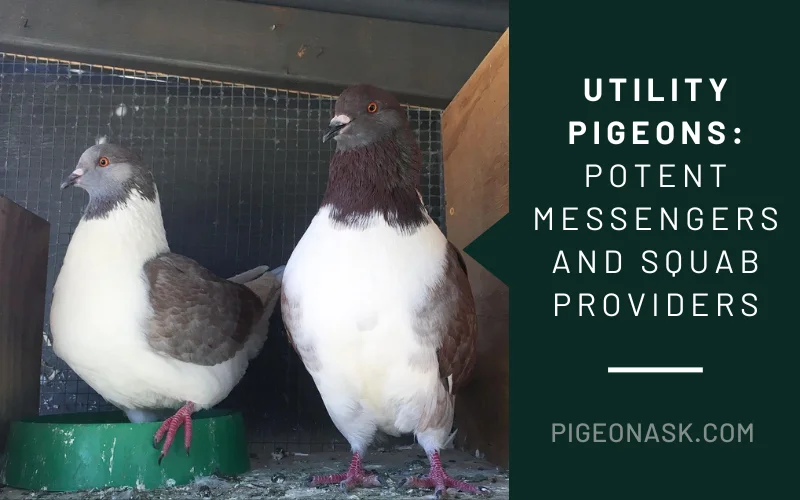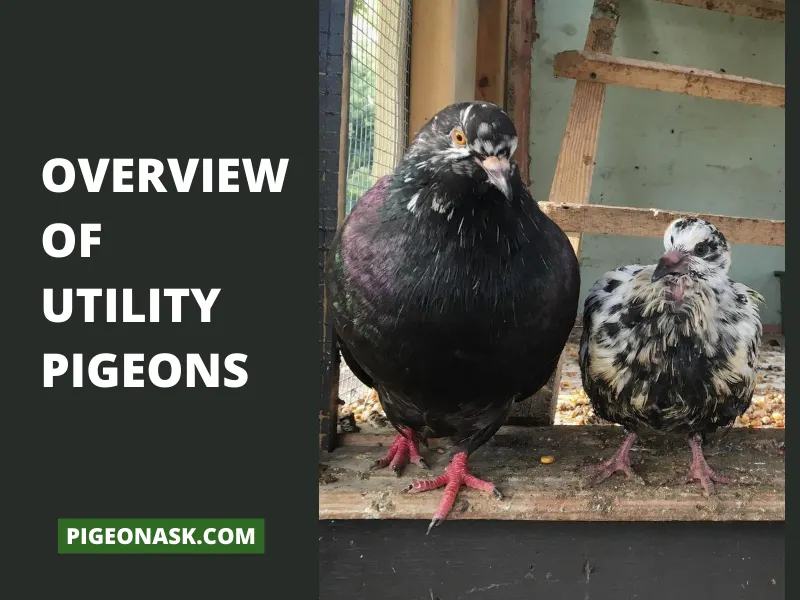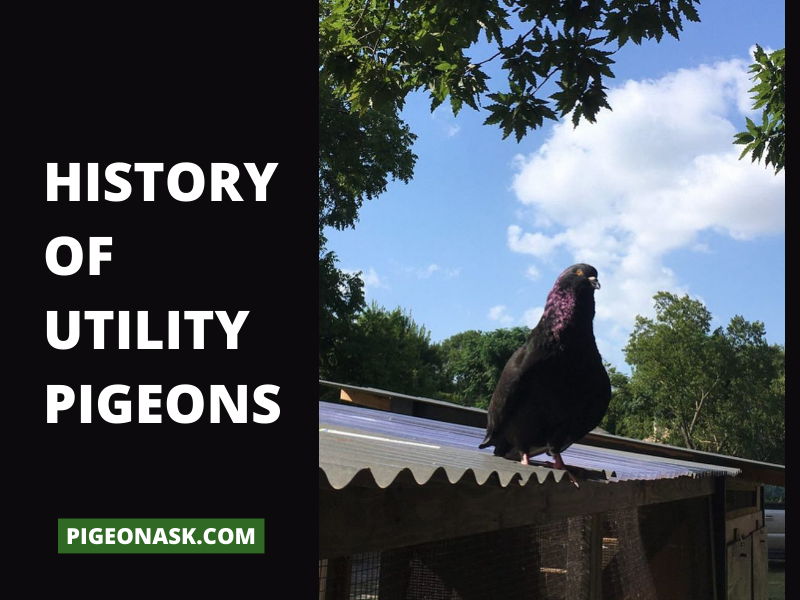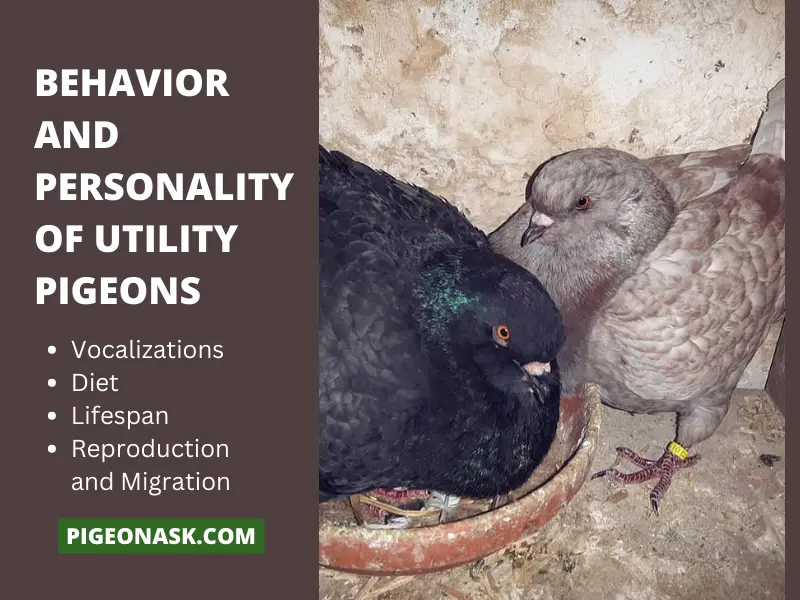5 Utility Pigeons Breed Guide (With Pictures)
Among the vast category of pigeons, utility pigeons always seem to get special treatment whenever historical impact or food production is concerned.
But what are utility pigeons? Why are they important? Utility pigeons are pigeons that possess exceptional navigational skills and, once trained properly, can be used for communication and delivery purposes. Apart from their messenger skills, these birds provide squabs, which is regarded as the only potent and beneficial meat production you can expect.
But there is a lot more than meets the eye when it comes to utility pigeons.
Are you interested to know more about them? Then keep reading this guide, where we will cover everything you need to know about these magnificent birds!

Utility Pigeon Profile
| Name | Utility Pigeon |
|---|---|
| Scientific Name | Columba |
| Common Names | 1. Carrier Pigeons 2. Squab Pigeons 3. Messenger Pigeons |
| Origin | 1. Egypt 2. Europe |
| Size | Small to Medium |
| Weight | Between 225 to 700 grams |
| Lifespan | 15 years |
| Physical Features | Oval-shaped head with multicolored feathers, compact yet strong body made for fast travels, superior eyesight |
| Temperament | Generally mild and co-operating with other birds & humans |
| Behavior | Friendly, non-aggressive most of the time, breed |
| Special Features | Able to make high-speed flights, exceptional navigating skills, perfect pigeon category for squab breeding |
| Breeding and Maintenance | Easy for breeding, requires proper feeding and selective pairing for optimal results |
| Common or Popular Varieties | 1. Carneau Pigeon 2. French Mondain Pigeon 3. King Pigeon 4. American Giant Runt Pigeon 5. Strasser pigeon |
Looking for more articles about pigeon type:
Overview of Utility Pigeons
Utility pigeons are widely known for their meat production capabilities. They are bred to provide squabs.
While this is a common misconception, utility pigeons aren’t a different pigeon breed; rather, they are pigeons from different breeds that are categorized together due to having certain features.

These features include being able to produce squab pigeons and having exceptional homing instinct, which allows these birds to serve as messenger pigeons.
This is why, unlike a single breed of pigeons, there is a variety of features and behaviors among utility pigeons.
Most Popular Breeds of Utility Pigeons
Utility pigeons serve various practical purposes, from meat production to message delivery. In this brief overview, we’ll explore some of the most common breeds of utility pigeons, each uniquely suited to fulfill specific roles in agriculture and communication.

Some of the most common breeds of utility pigeons are –
01. Carneau Pigeon
When it comes to homing and messenger responsibilities, the Carneau pigeon is not the best bet. But they belong to the utility pigeon category due to their ability to produce tender and flavorful squab meat.
With a short oval head, small beak, stout legs, and a compact body, you can easily understand why these birds are able to produce high levels of squab meat.
These are single-colored pigeons, but color varieties depend on the region and breeding factors.
02. French Mondain Pigeon
As the name suggests, these utility pigeons hail from France and have been widely used for pigeon racing and squab production. They also played a pivotal role as messenger pigeons but are now usually bred for their eye-catching beauty & grace.
They have an elongated body, long beaks, and arched neck, which provides them with a majestic outlook. Many breeders pick this pigeon for their looks only. These birds have multicolor feather variants and single solid-color feather variants as well.
03. King Pigeon
The king pigeon is one of the largest and most weighted pigeons among utility pigeons. They are well known for their elegant body structure and meaty breasts.
This allows them to become extremely well-squab providers under the right circumstances.
These birds have a small head compared to their large body size. They usually come in solid colors, mostly white. But there are other color variants out there, too.
04. American Giant Runt Pigeon
Arguably the largest utility pigeon out there, the American giant runt pigeon is well known for its capability to produce meat.
They can weigh over 1000 grams and have a robust body, which is ideal for those who want to start their personal squib production.
The heads of these birds are exceptionally large by pigeon standards, with thick beaks and bright eyes.
While they are friendlier to humans and other birds, these majestic pigeons don’t like to be bothered and appreciate anyone keeping their distance.
05. Strasser Pigeon
Strasser pigeon originates from Austria and is well known for their elegant outlook. They are fast fliers, making them the perfect utility pigeon for competition and pigeon races.
These are multicolored birds that have a unique crest design on them. They also have a broad chest, which makes them ideal for squab production as well. You can say that this bird is a bit of a jack of all trades among utility pigeons.
Apart from these well-known ones, there is also the Giant White Hubble, American Giant Homers, German Beauty Homers, Texan Pioneers and Modena pigeons who are known as utility pigeons due to their ability to produce squab.
Some other breeds of this pigeon types are –
| Breed | Unique Features |
|---|---|
| White King Pigeons | Large, white, broad chest, rapid growth, high fecundity |
| Giant Runt Pigeons | One of the largest breeds of pigeons, bred for meat production |
| Giant White Hubble Pigeons | Large breed of pigeon with white plumage, bred for meat production |
| Red Carneau Pigeons | Medium-sized breed of pigeon with red plumage, bred for meat production |
| French Mondaine Pigeons | Large breed of pigeon with unique appearance, bred for meat production |
| American Giant Homers | Large breed of pigeon with white plumage, bred for meat production |
| German Beauty Homer | Medium-sized breed of pigeon with unique appearance, bred for meat production |
| Texan Pioneer Pigeons | Medium-sized breed of pigeon with unique appearance, bred for meat production |
| White Carneau Pigeons | Medium-sized breed of pigeon with white plumage, bred for meat production |
| White Utility Modena Pigeons | Medium-sized breed of pigeon with white plumage, bred for meat production |
| White Utility Saddle Homer Pigeons | Medium-sized breed of pigeon with white plumage, bred for meat production |
| White Utility Swiss Mondaine Pigeons | Large breed of pigeon with white plumage, bred for meat production |
| White Utility West of England Tumbler Pigeons | Medium-sized breed of pigeon with white plumage, bred for meat production |
History of Utility Pigeons
Utility pigeons have been part of our history since ancient times. Proof of pigeon domestication has been found in ancient Egyptian markings.
Utility pigeons have also been part of Greek and Roman culture. They mostly played the role of carrier pigeons and in festivals or competitions.
The popularity of utility pigeons skyrocketed during the medieval era, especially in the western regions of Europe and the Middle East. This is due to the fact that utility pigeons were able to carry important messages discreetly and at a much faster pace.

During this time, pigeons with homing capability actually joined the utility pigeon rank permanently.
In the late 19th and 20th centuries, when pigeon messengers weren’t very effective, the use of utility pigeons moved to pigeon races and meat production.
Some believe the first introduction of utility pigeons in the United States was back in the 1870s. As pigeons at that time were called ‘Dutchies, ‘ many believe they originated from the Netherlands (or Holland) and Germany.
It has also been stated that Germans started to use pigeons as messengers at the beginning of the 1850s, so the close connection between the mass usage of utility pigeons across borders can easily be seen here.
This usage has only grown over time, and now utility pigeons are primarily being used for meat/squab production, various competitions, and aesthetic usage.
Common Physical Appearance and Features
Although the utility pigeon category consists of a wide range of pigeon breeds, there are certain features that allow us to differentiate them from other pigeon categories.

Size
The overall size of a utility pigeon will vary depending on what type of usage they have.
Small to medium-sized pigeons primarily focus on racing or homing actions, while the large ones, especially ones with a broad chest like the King pigeon, are bred for meat production.
Body Shape
There are three type of body shapes that is noticed among utility pigeons. Pigeons that are made to provide have a stout body type. These birds also have strong legs that can support their large body.
The ones that are for racing will have streamlined bodies. Pigeons bred for beauty contests, like the French Mondain Pigeon, will have elongated bodies and high necks.
Beaks
Lastly, utility pigeons that are bred for meat production have small beaks compared to pigeons that are bred for racing or aesthetic purposes.
Behavior and Personality of Utility Pigeons
In general, utility pigeons are docile in nature. They are calm and highly adaptable to environmental changes. These birds are also very social and rarely show aggression towards their companions.
We have also noticed that these birds have a general curiosity towards everything. This makes interacting with them a much more pleasant and enjoyable experience.

Let’s take a look at our evaluation of the behavior and personality of utility pigeons:
Vocalizations
Cooing is the go-to vocalization for most utility pigeons. However, the communication method and sound will vary depending on the pigeon species, not the category.
Sometimes, you may encounter some utility pigeons making chuckling noises.
Diet
The overall diet of utility pigeons will depend on what duty they will be performing. For meat production, the birds will take in more grains, while the minerals and vegetables will also come into play for racing.
Their diet generally consists of different types of grains and seeds like wheat, corn, peas, millet, and more. They also consume vegetables like spinach and lettuce.
Lifespan
Utility pigeons can live up to 15 years with proper care and support. But in the wild, their survivability can be challenging, which may result in them living for 5 to 10 years.
Reproduction and Migration
Almost every species categorized under utility pigeon is monogamous and only looks for a partner when the other passes. Generally, they will lay one or two eggs.
As for the migration, utility pigeons don’t make a far-fetched journey and mostly stay near their habitats. And as most utility pigeons are raised in a domestic setting most of their life, they don’t even bother to think about migration.
Geographic Distribution of These Types in World Wide
You will find that utility pigeons are distributed all across the globe. While their usage originated from ancient Egypt, their usage slowly moved west.
Generally, you will see the squab or meat-producing kind in Europe, Asia and the Middle East, while the racing and homing pigeons are found in Europe, North America and Asia. They’ve also been sighted in some parts of the Middle East.
The Popularity and Cultural Significance of Utility Pigeons
Utility pigeons have been around since the advancement of civilization, and it has been part of almost every existing culture in the world due to their effectiveness.

Traditional and Cultural Association
In Egyptian culture, utility pigeons were bred for rituals. These pigeons have also acted as symbols of various deities throughout Greek and Roman culture.
Utility pigeons also played a pivotal role in shaping various cultures’ communication and military sense. Their homing sense has opened up new strategies for tacticians and generals.
Pigeon Shows and Competitions
Beauty pageants and aesthetic bird shows always consist of utility pigeons. Many emperors and empresses also opted for pets as a show of beauty and elegance. These birds are also a frequent sight in bird racing competitions.
Breeding and Care Tips for Utility Pigeons
If you are planning on breeding utility pigeons for yourself, you will have to follow strict guidelines. Here are some tips that can get you started on the right path:
- Decide what type of purpose will your utility pigeon have; there are three types: meat production, race competition and beauty competition.
- Ensure that the pigeons have a clean and protective environment to nest in.
- Provide a balanced diet depending on your utility pigeon type; you may have to opt for some special foods for racing or squab-producing breeds.
- Make sure that the pigeons have nest boxes when their mating period begins.
- Monitor breeding pairs frequently and intervene if there is something out of the ordinary.
- Select proper training activities to deepen your breeding purpose.
- Make sure to keep the birds happy by letting them interact with one another; if you just keep them boxed in for breeding, then they will become depressed and lonely, which will affect the overall breeding purpose.
Conclusion
Utility pigeons are a fascinating pigeon category to breed. You can breed them in multiple ways, so this opens up doors for experiments as well. They can be good protein sources or a superstar in bird talent competitions.
However, you will have to take care of them and train them properly if you want to see successful results.
If you like this article, then make sure to read our other content as well. And don’t forget to follow us on our Facebook, Twitter & Pinterest page for more articles like this one!
